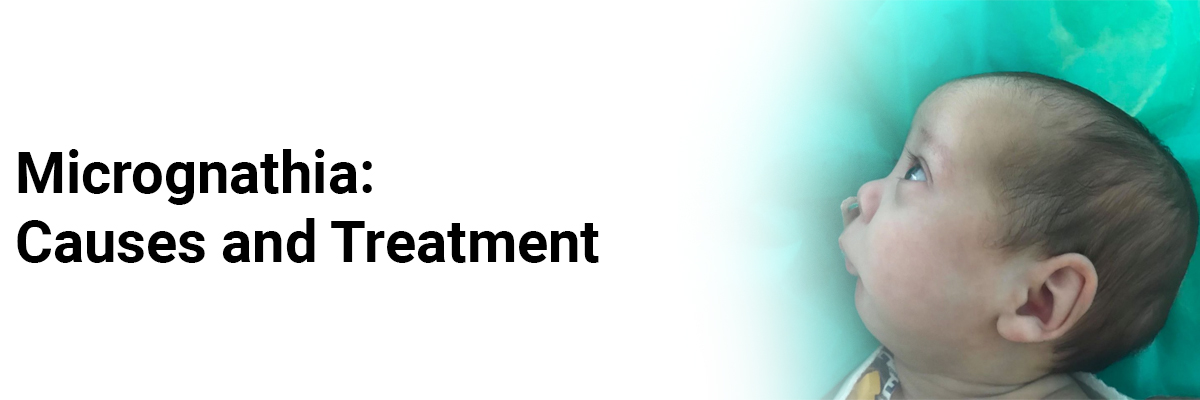
 Mrs. Mayuri Mathur
Mrs. Mayuri Mathur
Micrognathia: Causes and Treatment
Micrognathia, or mandibular hypoplasia, represents a condition in which the lower jaw is smaller than normal. It is common in babies and usually corrects itself as children grow older; however, some cases may need surgery depending on the severity of the condition. Micrognathia can also potentially block the airways resulting in chronic clinical adversities.
Most cases of micrognathia occur since birth. Sometimes, it may be associated with underlying genetic conditions, like cleft lip and palate, Pierre-Robin syndrome, and Treacher-Collins syndrome.
Retrognathia Vs. Micrognathia - Though retrognathia and micrognathia represent similar clinical conditions, they differ in their manifestation. Retrognathia is a condition in which the lower jaw is positioned abnormally in comparison to the upper jaw. However, Micrognathia presents a jaw that is smaller than it should be.
Predilection
Micrognathia is often present in babies born with certain genetic conditions, like Pierre Robin syndrome, progeria, etc. Sometimes it may also occur as a random genetic mutation.
Rarely can people also develop micrognathia later in life. Micrognathia in adults typically transpires because of trauma (like a cracked or dislocated jaw) or stiffening of the jaw to the head or temporomandibular joint (TMJ).
Cause
Micrognathia can be inherited due to a chromosomal abnormality or single gene mutation; it can be caused by an outside factor such as fetal alcohol syndrome or another medical condition.
Chromosomal abnormalities, such as Down syndrome, DiGeorge syndrome, and Treacher-Collins syndrome, are linked mainly with micrognathia. Other causes of micrognathia include genetic syndromes caused by mutations in a single gene, such as Stickler syndrome, Pierre Robin syndrome, and Pierre Robin sequence. Certain medical conditions, such as a cleft palate, a vascular malformation, or a tumor in the facial area, can also cause Micrognathia. In some instances, the source of the manifestation is unidentified.
Symptoms
Common symptoms of micrognathia in babies and children are:
• Noisy breathing.
• Sleep apnea or other breathing problems.
• Feeding-associated problem.
• Poor weight gain.
• Inability to sleep well.
• Trouble chewing, biting, or talking.
Micrognathia in adults can cause obstructive sleep apnea. Some people get relief with a CPAP machine, while others may need orthodontic braces or corrective jaw surgery.
Diagnosis
Diagnosing micrognathia is usually done through a physical examination and medical history. The clinician will inspect the patient's face and neck for signs of micrognathia. The doctor will examine the child's facial structures by
• Establishing a relationship between the child's upper and lower jaws.
• Determining the presence of any facial asymmetries.
• Looking for signs of cleft lip and palate.
• Checking the child's tongue position.
• Identifying the presence of tongue-tie.
Sometimes micrognathia is diagnosed even before the baby is born, using prenatal ultrasound. Imaging tests such as an X-ray, CT scan, or MRI can be used to confirm the diagnosis and assess the severity of the condition. In certain instances, it may be advisable to undergo genetic testing to ascertain any potential genetic factors that could be causing the condition.
If both the mother and her child have micrognathia, the doctor may recommend the following:
• Imaging tests, like X-rays or CT scans.
• A sleep study to monitor breathing, oxygenation, heart function, and brain stimulation during sleep.
Management and Treatment
Micrognathia can be managed non-surgically and surgically; the choice depends on the severity of the condition. It may include orthodontic treatment, jaw surgery to reposition the lower jaw, or a combination. To help the child eat properly, supportive measures such as changing their eating methods and providing special equipment may be necessary.
• Nonsurgical treatment strategies
The common nonsurgical treatments for micrognathia are:
o Positional therapy. It helps in keeping the baby's airway open. The healthcare provider may recommend specific sleeping positions.
o Nasopharyngeal tube placement. It involves inserting a device into the child's nostril and through the nasal passageway to keep the airway open.
o Positive airway pressure. It uses a bilevel-positive airway pressure or CPAP device to send air via a tube into a mask that fits over the child's nose. This continuous air pressure helps keep the child's airway open.
• Surgical treatment methods
In cases where nonsurgical options don't work, surgery may be necessary. Surgical treatments include:
o Tongue-lip adhesion. The surgeon attaches the base of the child's tongue in a more favorable position so it doesn't obstruct the airway.
o Mandibular distraction osteogenesis (MDO). It involves surgically lengthening the child's lower jaw to open the airway.
o Tracheostomy. It is reserved for rare instances where the surgeon creates an opening through the child's neck and into their windpipe, which bypasses the airway obstruction.
It is also essential to maintain follow-up visits with a doctor to ensure that the treatment is effective and that any complications are managed. In some cases, micrognathia resolves independently, usually by the time the child is 18 months old. In the meantime, the doctor will monitor the baby's progress.
Prevention
As micrognathia typically is a congenital condition, there's no method to prevent it. Additionally, there's no way to escape most of the underlying conditions associated with it.
The bottom line
Micrognathia is a relatively common condition in new-borns and often improves independently. In some cases, however, it can obstruct the airway and interfere with proper breathing and feeding. Contacting the healthcare provider to discuss the treatment options and determine the most appropriate option is essential.

Mrs. Mayuri Mathur
Mrs. Mayuri Mathur is a Senior Medical Writer (Patient education and digital) and seasoned content creator with a rich tapestry of expertise spanning over ten years. With a diverse background in content creation, she brings a wealth of experience to the table, from crafting insightful medical articles to developing comprehensive patient education materials, dynamic press releases, and captivating brochures and website content. Throughout her illustrious career, she has demonstrated an exceptional knack for distilling complex medical concepts into easily understandable content, making her a trusted resource for both professionals and lay audiences alike. Her meticulous attention to detail and innate creativity have enabled her to deliver content that not only informs but also engages and inspires. Whether elucidating intricate medical procedures or crafting compelling marketing materials, her versatility and dedication shine through in every project she undertakes. Her passion for writing, coupled with her profound understanding, makes her an invaluable asset to any team or project. In a constantly evolving digital landscape, where effective communication is paramount, Mrs. Mayuri Mathur stands out as a beacon of excellence, consistently delivering top-notch content that resonates with audiences across diverse platforms.

.png)

.png)
.png)




Please login to comment on this article